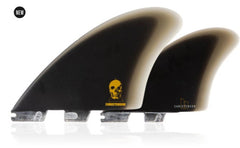Hawaiian South Shore October 2020 Newsletter
NEWSLETTER OCTOBER 2020

How to Face Your Fears in Bigger Waves

*Photo Timmy Reyes
With all of the heavy-water antics that the best in the world are doing these days, it is easy to become desensitized to big wave surfing. These days it can often seem like if you aren’t charging 50-foot Peahi, then you aren’t charging at all. But the reality is that we all surf at different levels, and that big waves and the fear that comes with them are largely relative. While it might take a massive Mavs bomb to get Aaron Gold’s blood pumping, for the beginner surfer who has only been at it for a few months, a head-high wave can feel huge. Part of the appeal of surfing is the experience of immersing ourselves in something that is so much bigger than we are, and part of that experience is the thrill that comes with leveling up and pushing our boundaries.
No matter what level you surf at or what “big” waves mean to you, it is possible to up your game by becoming more adept at facing your big wave fears. Here are a few tips for becoming more comfortable in heavy water.
1) Admit that you are afraid: most of the best big wave surfers acknowledge that not only do they get afraid sometimes, but that’s actually a good thing. When we aren’t afraid, it usually means that we are unaware of the potential
consequences of our actions. If this is the case, we are liable to push too hard and get hurt (or worse). Besides, fear is what gives us that little shot of adrenaline when we surf bigger waves than we are comfortable with. If you have a desire to surf bigger waves, that means you enjoy being scare. Embrace that fear and you will be able to make it work for you, rather than against you.
2) Think logically about your fear: What is it about the waves you are surfing that scare you? Is your fear rational, or is it an emotional reaction to the power of the ocean? If you are surfing over dry reef, then you probably have a logical reason to be afraid. But if you are at a deep-water spot and it isn’t downright
enormous, you are more than likely reacting to the perceived thread of being out of your comfort zone, rather than an actual danger. Evaluate your fear, and decide if it is one that is warranted or not. If there is real danger, then maybe this is a far you don’t want to move past. If the danger is more in your head than in
reality, then it’s time to start chip-ping away at it and getting more comfortable.
3) Know your ability: Another part of facing your fears in the ocean is being aware of your physical abilities. It is one thing to push yourself to go bigger when you have the skillset to do so, but it is something else entirely to try to charge when you are lacking basic surf ability. The former is a great way to progress, but the latter is a great way to get injured. As you become a better surfer, you will be able to paddle faster, read the ocean better, and take steeper, later drops. Allow your ability to dictate how far you are willing to push the envelope. But at the same time, don’t undersell yourself. Look around at people who surf at your level, and observe the size of waves they are surfing.
If they can do it, so can you.
4) Count while you are underwater: Perhaps the biggest driver of panic when surfing is the fear of drowning. Being held underwater can be very unnerving, but the reality is that very few hold downs last longer than 10 to 15 seconds. It is very rare for a beating to last more than 20 seconds unless it is a two-wave hold down, and those only tend to happen when the waves are in the legit XL+ range and even then they are very rare. Next time you wipeout on a big wave, count slowly underwater and see how far you actually get. Once you begin to realize that your hold downs are never lasting more than 10 to 20 seconds, you will be much more confident surfing larger waves.
5) Increase your lung capacity and comfort with apnea: A few years ago, Hawaiian South Shore writer and resident big wave surfer Matt Rott was lifeguarding on Namotu Island in Fiji. Most of the guests were middle-aged chesthigh Namotu Lefts, rather than big, bombing Cloudbreak. In other words, these weren’t people who spend a lot of time preparing for big waves and doing apnea work. When Matt sat the entire camp down for an O2 table session, no one expected to make it longer than 30 or 45 seconds. But half an hour later, every guest at the camp had held their breath over three minutes, with one guest making it to 3:45. Matt’s personal best is six minutes, and he doesn’t think he has come close to his max yet. The moral of the story? We can all hold our breaths much longer than we think—and once we know that, we can approach large waves with more confidence.
6) Train: Surfers never used to train, but these days if you are serious about big waves and you don’t do yoga, cardio, and other crosstraining, then you are fooling yourself. But big wave guys aren’t the only people who can benefit from training. Remember, “big” is a relative term. Even if you are only looking to progress from head-high waves to doubleoverhead, having great cardio fitness will give you the ability and confidence to do so. It doesn’t matter if your training involves gym workouts, paddle sessions, pool workouts, running, mountain biking, Pilates, Cross Fit, rock climbing, yoga, or any other type of physical workout—what matters is that you are improving your fitness so you can survive and thrive in frightening conditions.
7) Have the right equipment: fear in heavy can often be an emotional reaction that is blown a bit out of proportion—but there are also situations that really do pose a threat to your safety, and are frightening for justifiable reasons. If you are surfing huge outer reefs or super shallow slabs, there are a number of tools
you can use to help to ensure your safety (and thereby lessen the fear factor). Helmets are a great idea in shallow barrels, while flotation vests, the appropriate boards and leashes, and even a safety team on a ski can help keep you
safer in XL+ wave. Even smaller “big” waves are less frightening when you know you have the right equipment (for instance, you wouldn’t want to paddle out on a traditional noserider with a comp leash the first time you ever face down double-overhead barrels). Whether you are surfing four-footers or 40-footers, make sure you have the right gear!
The team here at Hawaiian South Shore can help point you in the right direction, and set you up with the perfect kit depending on your surfing ability and big wave experience, and how far you are looking to progress.
WHAT’S NEW AND HAPPENING AT HAWAIIAN SOUTH SHORE
We’re a FCS premier dealer and when things are releases we usually have them already in stock or they will be landing in a few days. If you follow us on Instagram you’ll get word as soon as they are available at the store and on our website. Free shipping to all our Local folks and to the Mainland. We do our best to drop it off at the main post office so usually you’ll get it in 2 days.
The New Rob Machado Thruster Pivot fins. Wide and stubby for drive and release off the top. It comes in FCSII and Futures.

FCS II Rob Machado Tri Keel Fins
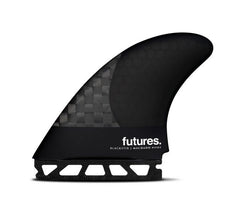
FUTURES Blackstix Rob Machado Pivot Large Thruster

The CI Keel with 70/30 foil and up right design

FCS Chris Christenson New Keel Twins
October Member of the Month - Hoku
Here at Hawaiian South Shore we love our customers—they are the reason we exist, and styling them out with new boards and gear has been my main source of stoke for over 20 years.
Every now and then we like to pull frequent customers aside for a quick interview, to find out about their surfing experiences, what they like, and how they keep the wave riding dream alive. Hoku and his crew come into the shop all the time, and are always bringing positive vibes with them. They are super down to earth, stoked on life, and always frothing for a surf. Last week, I chatted with Hoku for awhile to get his perspective on surfing, boards, and life in general.
Hoku’s cousins took him surfing for the first time on Molokai, where his family is originally from. His first session was in fifth grade, but he soon was out at Walls and Ala Moana every day, getting more and more excited about surfing. These days, his home breaks are Courts and Big Rights, both in Ala Moana Beach Park. Then, after surf sessions, he either cruises over to Whole Foods to get some after-surf grinds (he especially loves the strawberry shortcake), or heads home to barbecue with friends and family. When he isn’t surfing, he also enjoys golfing, and makes his living driving trucks for the state.
Hoku recently picked up a 9’1” Kai Sallas “Camper” in Thunderbolt Xeon construction, and is fully in love with the board. He says that it paddles super well, is ultra light, and rides unreal. It has all of the benefits of epoxy board (like strength, durability, flex, and light weight), but isn’t corky like the other epoxy boards.
Keep your eye out for Hoku and his crew next time you are in the shop or surfing Ala Moana Beach Park!
The Halo Advantage
While Donald Takayama’s contribution to surfing and surfboard design runs the gamut from longboards to short, and even includes a storied career as a professional competitor, perhaps his most futuristic and visionary invention is the Halo Fin. Drawing on the theory behind the pivot fin, Takayama sought to create a fin system that allowed larger wave riding vehicles such as longboards, SUPs, and shorter hybrids to turn with ease and efficiency. And when he finally nailed the science and perfected the design, it was quintessential Takayama to give it the simplest name possible—Halo, which means “fin” in Hawaiian.

There are two major notes of interest when it comes to the Halo Fin. First, the center and side fins work together closely. In fact, the center fin can be considered an extension of the side fins. Thus, this isn’t a setup where you want to slap a center Halo onto a board with a pair of random standard fins. In fact, if you look closely at the outline of the typical fin versus a Halo side fin, you will notice that the orientation of the fins are almost completely opposite. That is the genius of Takayama’s invention.
While the standard keel fin (from which all modern fins are descended) has a leading edge that is rounded back, and then a trailing edge that is straight or nearly vertical in orientation to the bottom of the board (modern keels and standard shortboard fins are simply keels with adjustments made to the shape of the trailing edge), the Halo side fins are actually reversed. The leading edge is straight while the trailing edge is curved. This may seem to fly in the face of everything that we “know” about modern fin design, but Donald Takayama was never afraid to think for himself, and what he found was that this fin setup allowed for sharper, more responsive turns on larger boards—even when the surfer wasn’t standing over the fins. (This last point is important, because one of the limitations of large boards such as longboards and SUPs is that they can typically only be turned from the tail).
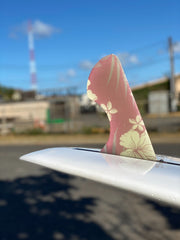
The Halo center fin is an interesting hybrid. In many ways, it resembles the standard pivot fin (which Takayama has also been credited with inventing). However, if you compare the shape of a side Halo fin to the tip of the center Halo fin, you will find that they are practically identical. In essence, Takayama has taken a side Halo fin and extended its length, creating a Halo-ended pivot fin that works in concert with the side fins.
While the Halo setup was originally intended to be surfed as a 2+1 setup, many people remove the side fins on occasion to create a single-fin setup.
Removing the side fins makes a board looser and more free-flowing, which creates a great feel on small waves. Meanwhile, the Halo center fin can be used as a single fin on traditional logs, although you will typically want to size the fin up if you are using a Halo as a single fin on a log, as Halos tend to be looser than most other fins of the same size. The extra length provides more control and speed.
When all the elements in the Halo 2+1 setup come together, what you get is a more efficient, faster fin setup that increases drive while also improving turning radius. Because most fins need to compromise between drive and maneuverability, it would seem that the Halo fin is the mythical silver bullet, providing both, rather than sacrificing one for the other. And that is exactly what Donald Takayama intended. For those looking to spice up the ride on their modern longboard, SUP, or even mid-length quad, it’s pretty difficult to find a setup more cutting-edge than the Halo Fin.
Hawaiian South Shore is one of only a few distributors worldwide carrying the Halo Fin. For more info on the design, check out hawaiiansouthshore.com and search for Halo. Shipping is Free for all US addresses. For our local members it usually take about 2 days, mainland west coast 3 to 4 days and east coast 5 days.

Keiko Cooking Kabocha
Ingredients:
Water 100cc (roughly 7 tablespoons)
Shoyu 15ml (3teaspoons)
Mirin 15ml
Sake 15ml
Sugar 15ml
Med heat boil
Simmer about 20 min..until soft check with chopstick

As you probably know, food and culture are two of my favorite topics—and when the two intersect, that’s when I get really excited. One of my favorite traditional Japanese dishes is a nimono (simmered food) made with kabocha. Kabocha is also known as Japanese pumpkin, and, lucky for me, it’s one of my wife Keiko’s favorite dishes to cook. She’s a great cook, and loves talking to the chefs at Japanese restaurants to learn new tricks and recipes. Her kabocha recipe is one of the best I’ve ever tasted, and is super healthy too! Kabocha is full of nutrients such as beta-carotene, vitamin C, iron, and B vitamins, and has less calories than most other squash varieties. Plus, Keiko makes her kabocha dish healthier than most by minimizing the sugar that is added.

To prepare the dish, she cuts the kabocha in half and removes the seeds, then cuts it into pieces, which she places skin-side down in a pot. This is to help the kabocha to not fall apart while cooking. She then adds 7 tablespoons of water, 3 teaspoons of shoyu, and 15 ml each of sake, mirin, and sugar. She brings this all to a boil, then lowers it to a simmer. Once it’s simmering, she places an otoshibuta on top. An otoshibuta is a round lid that is slightly smaller than the circumference of the pot, and that sits directly on top of the food that is being simmered.

You can make one by taking a piece of wax paper, cutting it into an appropriately size circle, then cutting holes around the edges and in the middle. My mother used aluminum foil. The otoshibuta ensures that the heat is evenly distributed, cook quickly and absorb all the flavors. Liquid circulates to the lid , coats the top of the ingredients, so you don’t need to stir with a spoon. This is so you it won’t break them apart. Plus it prevents the liquid from evaporating.

After around 20 minutes, the kabocha should be ready. You can tell if it’s done by poking it with a chopstick and seeing if it is soft. You can stick the chopstick straight through the holes in the otoshibuta to check! Once it’s done, you can eat it with rice and other staples. You can even eat the skin, which is super healthy for you!

Keiko has shopped all around Oahu looking for the best kabocha. Many of the grocery stores, like Times and Safeway, have kabocha that is soft and watery and not very flavorful. We think that the kabocha from Nijiya is the best on the island. There are two Nijiyas on Oahu—one in Puck’s Alley by the university, and one on Piikoi Street. Nijiya also has great bentos that you can pick up while you are shopping for kabocha! Enjoy!
Young Song Loves Thunderbolt Boards
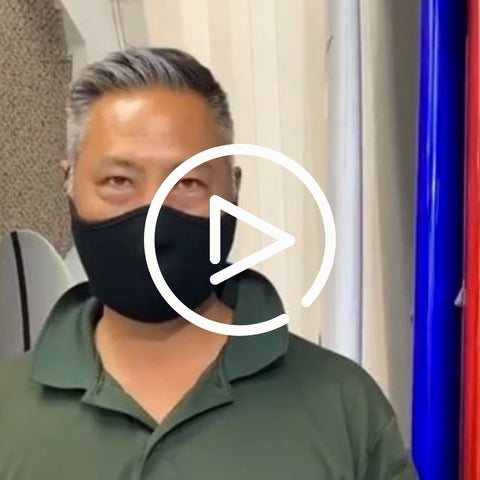
Young Song has a nice collection of Thunderbolt longboards, including a 9’1” Smoothie and 9’6” Peacemaker from Ben Skinner and a newly arrived 9’1” TJ Pro from Dan Mann. When he came in to pick up his new TJ Pro, we chatted with him about his Thunderbolt boards, and why Thunderbolt tech creates such great boards.
Young finds that the Smoothie performs better in bigger waves, and uses the Harley extra large thruster setup on the board. Meanwhile, the Peacemaker works well for him on small days. He rides it as a single fin, with a 9-inch fin. It’s a bit different than what he has normally ridden over the years, which are mostly performance boards, but Young has really enjoyed the feel of the Peacemaker single fin.
Young is a solid guy—6’2”, 225 pounds—and finds that the 9’1” Smoothie and 9’6” Peacemaker float him well. He wanted to try out another high-performance longboard, so that’s why he decided on the 9’1” TJ Pro.
The Thunderbolt construction on all three of these boards are part of the secret to why they ride so well. With the strength and lightness of epoxy combined by the futuristic flex patterns of inlaid carbon fiber stringers, Thunderbolt has taken some of the best designs from the world’s leading longboarders and shapers and elevated them to the next level.
Kawika Reviews the Hydroshort
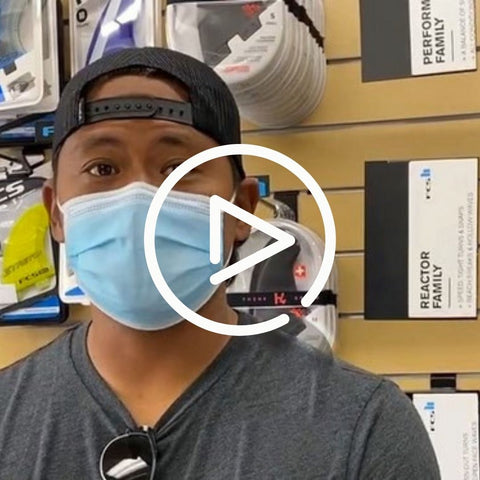
Recently one of our favorite customers Kawika came in to pick up the new Sci-Fi 2.0, and while he was here he gave us a review of the Hydroshort, which he tested out recently. Kawika said that his Hydroshort is a 6’1”, and made him feel like he was back in his hey day! He surfed it in waist- to chest-high waves and found that it went super fast. The board has a volume of 36 liters and Helium construction, and worked well with his weight (around 200 pounds). He used the Pyzel all-around fins on the board, and found the combination to be great for high-performance surfing.

